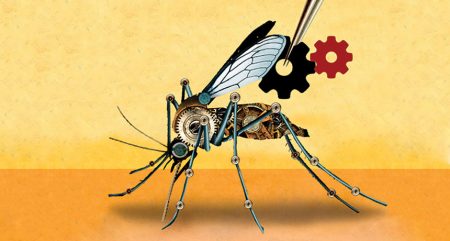December 24, 2016 – Human evolution and in fact the evolution of all life on Earth is about to change because of a new technology called gene drive. It involves adding or removing genetic information in DNA. CRISPR/Cas9 is the current hot tool for modifying life here on Earth. We can use it to recreate extinct life. We can enhance existing life. And the U.S. military sees in this the potential to engineer genetic mischief or worse unleash a global pandemic.
The U.S. military through DARPA is one of the largest funders of gene drive research. And in a Scientific American article on the subject, DARPA program manager, Renee Wegrzyn, states, “if we’re going to be really bullish about genome engineering, we need to be just as aggressive with tools to reverse those changes.” She heads up a team focused on inhibiting unwanted genetic changes and reversing them. One line of research involves developing molecular tools to combat a genomic editing that produces undesirable results. It could be delivered in a pill. Another area of research looks at ways to overwrite gene mutations to reverse unintended effects.
Gene drives today are seeking ways to control mosquito populations that spread diseases like Zika, Dengue, Chikungunya and Malaria. The technology is seen as so powerful that companies like Oxitec, the Oxford University spinoff that produces and releases genetically modified mosquitoes and other insects, believe within a generation we can wipe out public health scourges this way.
A project, Target Malaria, focuses on doing just that in sub-Saharan Africa. Variants of female Anopheles mosquitoes are the target. Gene drive technology is being used to create a number of potential outcomes. One targets fertility genes to make them no longer function. Another targets the genes responsible for allowing mosquitoes to host malaria pathogens. Modifying the genetic structure of the insect makes the offspring perform in ways that reduces traits that contribute to the spread of the disease in human populations.
How the gene drive works is simple. The technology uses DNA-cutting enzymes, called nucleases, to cut and paste new instructions into one or more chromosomes. In this way you create an insect population with new characteristics. For example, a mosquito that resists becoming a malaria or other pathogen host. Or a population of insects that produces only male offspring who not only don’t bite but don’t reproduce.
You can make a gene drive fool proof so that the inherited trait happens 100% of the time unlike the process of natural selection where genes of a parent are passed to offspring only 50% of the time. Eventually the genetically-modified insect becomes dominant or, in the case where you create an all male offspring population, extinct.
The dark side to eliminating a disease spreading species of insect is unintended consequences. Suppressing one species may kick-start a competitive species capable of producing a whole new series of pandemics. Once we start toying with natural ecosystems the consequences can be mighty serious.
And then there is the potential for malicious gene drives with humans turning the technology into a weapon targeting us. The mechanism to spread a pandemic-causing outbreak in a human population could be delivered through an insect bite, or an aerosol, through the water system or food supply that alters our chromosomal construct.
Engineering genes safely and ensuring we have the means to deconstruct or reverse what is created, therefore, is of primary importance. The safeguards we put in place must surpass even those currently used by nuclear weapons programs.









